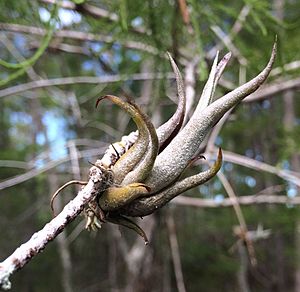Potbelly airplant facts for kids
Quick facts for kids Potbelly airplant |
|
|---|---|
 |
|
| Tillandsia paucifolia on a slash pine tree in Fort Myers, Florida |
|
| Scientific classification | |
| Kingdom: | |
| (unranked): | |
| (unranked): | |
| (unranked): | |
| Order: | |
| Family: | |
| Subfamily: |
Tillandsioideae
|
| Genus: |
Tillandsia
|
| Subgenus: |
Allardtia
|
| Species: |
T. paucifolia
|
| Binomial name | |
| Tillandsia paucifolia |
|
| Synonyms | |
|
Tillandsia bracteosa Klotzsch ex Beer |
|
The Tillandsia paucifolia, also known as the potbelly airplant, is a special kind of bromeliad. It belongs to the Tillandsia group, which are often called airplants. This plant naturally grows in Central America, parts of Mexico, Venezuela, Colombia, the West Indies, and Florida.
Tillandsia paucifolia can grow by itself or in groups. It usually has about five to ten leaves. These leaves are light green and silver-gray. They are short and become narrow at the ends. A cool thing about T. paucifolia is its large, round base, which makes it look like it has a "potbelly." This helps tell it apart from other airplants. The leaves are covered in tiny, hair-like structures called trichomes. These trichomes help the plant soak up water and nutrients right from the air, like sponges! The trichomes on Tillandsia paucifolia are extra big and there are lots of them.
Reproduction
Tillandsia paucifolia are flowering plants, which means they make flowers to create seeds. Their flowers can be pale pink or a pretty lavender-blue color. These airplants rely on animals to help them reproduce.
Many animals visit these flowers to help with pollination. During the day, bees, beetles, and hummingbirds often do the job. At night, moths and bats have been seen helping too. The plants sometimes make a sweet liquid called nectar as a treat for these animal helpers. When more animals visit, the plants get different kinds of pollen, which helps them make stronger, healthier seeds.
Where Airplants Live
Tillandsia paucifolia are epiphytes. This means they grow on other plants, usually trees, but they don't take food or water from them. They are not like parasites. Instead, they just use the trees for support, like a comfy home. Unlike most plants, they don't have roots that go into the soil. Their roots are mainly for holding onto the tree branches.
In places like southwest Florida, you'll often find T. paucifolia growing on slash pine trees. But they can grow on many other types of trees too. Even though they don't harm their host trees by stealing nutrients, if there are too many airplants on one tree, or if they grow in certain spots, they can cause problems. A tree with lots of airplants might get stressed because it doesn't get enough nutrients itself. Also, a large group of airplants can make tree branches break or create too much shade for the tree's own leaves.
Cultivars
- Tillandsia 'Aleta'
- Tillandsia 'Ask Harry'
- Tillandsia 'Asombroso'
- Tillandsia 'Diana'
- Tillandsia 'Frolic'
- Tillandsia 'Humbug'
See also
 In Spanish: Tillandsia paucifolia para niños
In Spanish: Tillandsia paucifolia para niños

